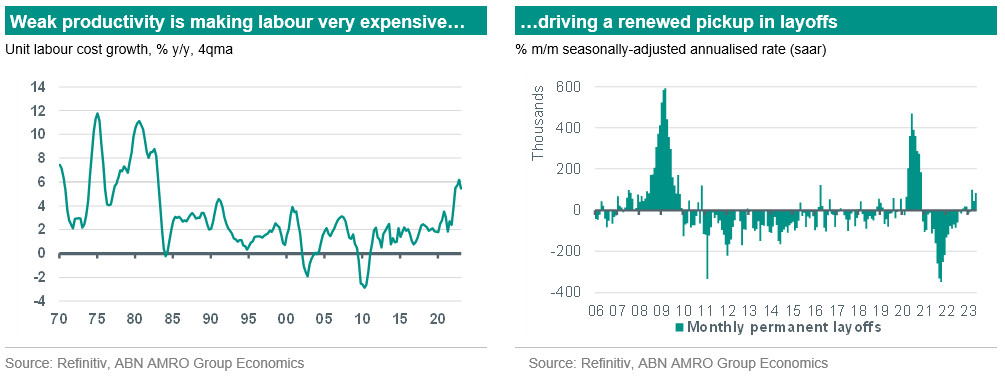US recession to start in Q4; Fed cuts delayed to March

We now expect a US economic downturn to begin in Q4 2023. We have upgraded our 2023 growth forecast, but significantly downgraded our 2024 forecast. More near-term resilience will now likely mean a later start to interest rate cuts - and therefore a more prolonged period of highly restrictive monetary policy.
Recession now expected to start in Q4
We have updated our US macro scenario, and now see a recession starting in Q4 this year; previously we expected a downturn to begin in the current quarter. The trigger for our change has been the recent resilience in jobs growth and consumption, which has offset weakness elsewhere (particularly manufacturing and housing). While retail sales have essentially flat-lined in real terms (i.e. after adjusting for inflation) in recent months, this will not be enough to drive an outright decline in private consumption in the current quarter given that services consumption continues to recover from the pandemic (albeit at a modest pace). This is being driven partly by continued strength in consumer credit growth, which for the time being is offsetting the weakness in real incomes and the decline in excess savings. Meanwhile, though cracks in labour market strength have appeared in recent months in the form of rising layoffs, jobs growth in aggregate has remained robust for the time being, reflecting persistent labour supply/demand imbalances and labour hoarding behaviour since the pandemic.

Why do we still expect a recession?
Given that the US economy has persistently defied recession expectations so far, it is reasonable to ask whether the economy will really go into recession at all, despite the headwinds. We think it will, because we view the drivers of the recent resilience – the strength in both consumer credit and jobs growth – as unsustainable. First, the combination of significantly higher interest rates and much tighter bank lending standards is likely to drive a cooling – and ultimately declines – in consumer credit over the coming months. Second, as consumer demand has cooled, employment growth has considerably outpaced GDP growth in recent quarters, with the result being falling productivity and a jump in unit labour cost growth. For this to continue, businesses would need to accept a sustained fall in profit margins, which we view as unlikely. Indeed, the fact that gross layoffs have risen suggests a significant number of employers have already started the cost-cutting process, it is just that this is being offset for now by strong demand elsewhere in the labour market. It is historically unusual to see such a fall in productivity and a rise in layoffs and for this not to lead to a meaningful rise in unemployment. We therefore think it is a matter of time before job-cutting behaviour spreads more widely, with rising job losses – and the hit to labour market confidence – driving a bigger hit to consumption.

More near-term resilience means a weaker 2024
In quarterly terms, we now expect growth to be stagnant in Q3 after growing modestly in Q2, and for this to be followed by a contraction in output in Q4 2023, which continues into Q1 2024. Given the later expected onset of recession, we also delay the expected recovery to later in 2024. The net result of these changes is to drive an increase in our 2023 annual average growth forecast – to 1.4% from 0.7% previously – but for this to be more than offset by a large downgrade to our 2024 growth forecast, to just 0.3% from 1.6% previously.
Our new US macro forecasts

Note: Quarterly GDP forecasts are % q/q saar; annual is the % y/y annual average. Unemployment is the average % rate for the quarter (year). CPI inflation is the % y/y average for the quarter (year). Source: Refinitiv, ABN AMRO Group Economics
Fed rate cuts now to begin in March 2024
An additional reason we expect a weaker recovery in 2024 is that we now expect the delayed recession to mean a later start to Fed rate cuts, meaning a more prolonged period of highly restrictive monetary policy. We now expect Fed rate cuts to start in March 2024, one quarter later than our previous December 2023 expectation. Combined with the additional July hike that we added to our profile following the June FOMC meeting last week, this leaves the fed funds rate 75bp higher at the end of 2024 compared with our pre-FOMC forecast, at 3.50-3.75%. This is still significantly lower than the latest FOMC median forecast of 4.6%, and this is due to the bigger hit to GDP growth and the bigger rise in unemployment that we expect. To illustrate, the June FOMC median Q4/Q4 GDP growth forecast is at 1% for 2023, with our equivalent forecast at 0.4%, while we expect unemployment to peak at 4.8% in Q4 2024 compared with the FOMC median expectation of 4.5%. We think the combination of modestly falling payrolls and m/m core inflation close to – but somewhat above – the Fed’s 2% target will be enough to trigger the start of an easing cycle by next March. With regards inflation, we will provide a more detailed outlook update in our June Global Monthly.

What does all of this mean for the ECB, rates and FX?
We maintain our expectation for the ECB to start cutting rates in December given that the eurozone economy has already entered a recession. We are currently reviewing the implications of our Fed scenario update for rates and FX markets and will update in due course.
